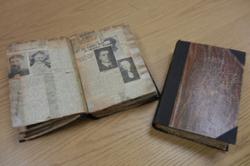Connecticut Historical Society Unveils New Resources for Historians & Genealogists

Hartford, CT (PRWEB) May 30, 2012
Stories from the past have been handed down from one generation to another through various means. The most consistent of these have been documented in newspapers and books. Historians face challenges such as the degradation of paper and the fading of words and images. In order to preserve antique books, librarians store books in climate controlled rooms, avoid their exposure to UV rays, and limit how much books are handled. Keeping a book free from dust will also prolong its life. While all of these methods assist in preservation, they also limit the access to the knowledge within these books and, therefore, are not convenient for historians.
The Connecticut Historical Society(CHS), in Hartford, Connecticut, has faced the issue of degradation due to aging documents. Their collection documents social, cultural and family history. Founded in 1825, CHS is a museum, library and research/educational center. Conservation has been a priority for CHS for years. In the past, CHS copied fragile collections, including paper documents, on to microfilm. Obituariesvaluable resources for Genealogy
and social history researchwere some of the first documents to be copied. However, other collections needed to be preserved as well.
In the early-20th century, Mary Morris compiled two collections of scrapbooks of newspaper clippings, mainly from the Hartford Courant. The clippings included obituaries, but more notably, she also collected clippings of social events. Morriss scrapbooks included information about weddings, social events, coming-out parties and the like from the local paper. These clippings ranged in date from 1889 to the 1920s.
While the obituary notebooks had already been preserved on microfilm, the social scrapbooks had not. Barbara Austen, the Florence S. Marcy Crofut Archivist at CHS, was concerned about the significant collection of social events being destroyed. Austen observed, The papers were literally turning into confetti. These scrapbooks did not just document social engagements; they also shed light on the lifestyles of our citizens during this time.
Merritt Scanning, a division of the Joseph Merritt Company, contacted the CHS to see if they had any documents that could be preserved through digitization. A donor had just made funds available to the CHS for the purpose of preservation. Austen knew at once which project she would select Mary Morriss social scrapbooks.
With their state-of-the-art book scanner, Merritt Scanning was able to digitize the scrapbooks without harming the originals. The scrapbook pages were turned into PDF documents. The scrapbooks can be safely stored again, but their information is now accessible. Merritt Scanning did a beautiful job, and most importantly, digitizing gave use of the knowledge back to the public, Austen commented.
To learn more about the Connecticut Historical Society, please visit http://www.CHS.org.
To learn more about Merritt Scanning, please visit http://www.merrittscanning.com
